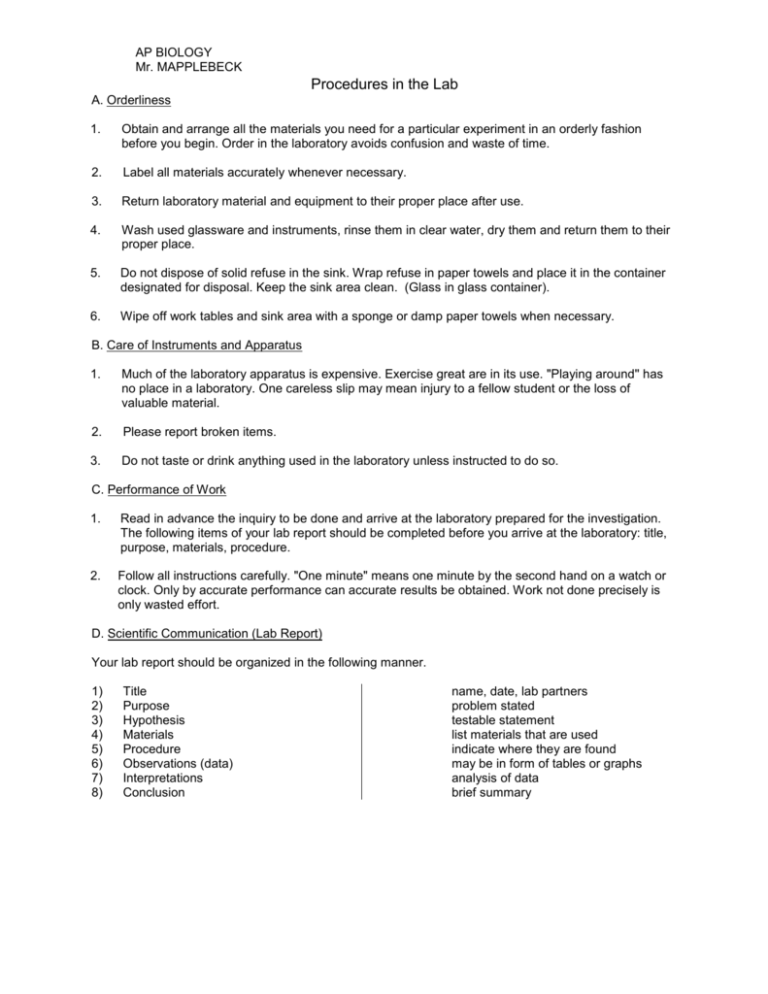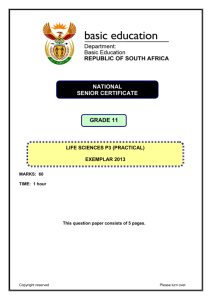Lab Write Up
advertisement

AP BIOLOGY Mr. MAPPLEBECK Procedures in the Lab A. Orderliness 1. Obtain and arrange all the materials you need for a particular experiment in an orderly fashion before you begin. Order in the laboratory avoids confusion and waste of time. 2. Label all materials accurately whenever necessary. 3. Return laboratory material and equipment to their proper place after use. 4. Wash used glassware and instruments, rinse them in clear water, dry them and return them to their proper place. 5. Do not dispose of solid refuse in the sink. Wrap refuse in paper towels and place it in the container designated for disposal. Keep the sink area clean. (Glass in glass container). 6. Wipe off work tables and sink area with a sponge or damp paper towels when necessary. B. Care of Instruments and Apparatus 1. Much of the laboratory apparatus is expensive. Exercise great are in its use. "Playing around'' has no place in a laboratory. One careless slip may mean injury to a fellow student or the loss of valuable material. 2. Please report broken items. 3. Do not taste or drink anything used in the laboratory unless instructed to do so. C. Performance of Work 1. Read in advance the inquiry to be done and arrive at the laboratory prepared for the investigation. The following items of your lab report should be completed before you arrive at the laboratory: title, purpose, materials, procedure. 2. Follow all instructions carefully. "One minute" means one minute by the second hand on a watch or clock. Only by accurate performance can accurate results be obtained. Work not done precisely is only wasted effort. D. Scientific Communication (Lab Report) Your lab report should be organized in the following manner. 1) 2) 3) 4) 5) 6) 7) 8) Title Purpose Hypothesis Materials Procedure Observations (data) Interpretations Conclusion name, date, lab partners problem stated testable statement list materials that are used indicate where they are found may be in form of tables or graphs analysis of data brief summary AP BIOLOGY Mr. MAPPLEBECK AP BIOLOGY LABORATORY INVESTIGATION REPORT FORM Mr. MAPPLEBECK NAME: INVESTIGATION TITLE: LAB PARTNER(S): DATE: Purpose: - Write out a brief description of why you are performing the investigation. State the question or problem which you are trying to answer or solve. - The purpose of each investigation is in your handouts, or will be given to you, or you will write your own from the introduction. Hypothesis - This should be a testable statement that includes an “If, then” statement. The first part of the hypothesis should include your independent variable and be followed by the dependent variable. Materials & Equipment: - You do not have to list the materials used but simply indicate on which pages they are listed in your text. (E.g., materials are outlined in text on pp. ). - Each Lab Report should have a large, neat, well-labeled diagram of your laboratory set-up unless instructed otherwise. - Diagrams should be done in pencil. Write a title above the diagram. - Print the names of the various parts of the apparatus and use straight arrows to join the part of the apparatus to the name. Procedures: - Do not copy out the procedures but simply indicate where they can be found if they are in a lab guide. (E.g., We used procedures as outlined in text on pp. .) Add special instructions. You will have to write out the procedure if you are doing an original experiment. Observations and Data: - Observations can be recorded in the form of sentences that are numbered or lettered to correspond to the letter of the procedure. - Numerical data is best recorded in the form of a chart or table with appropriately labeled columns. - Use the following four senses when making observations (sight, smell, touch and sound). - Accurate observations require accurate measurement of time, distance, volume, mass and temperature. Interpretations: - Do not copy questions but answer them with complete sentences. In this way the question as well as the answer will be recorded. - If you can answer the questions in the light of what you have observed, then you have learned from this investigation and benefited from a scientific study. Conclusion: Your conclusion should summarize all the scientific knowledge that you have learned from your investigation. In drawing up a conclusion, refer to the purpose of the investigation and state possible answers to the questions or problems you were investigating.











